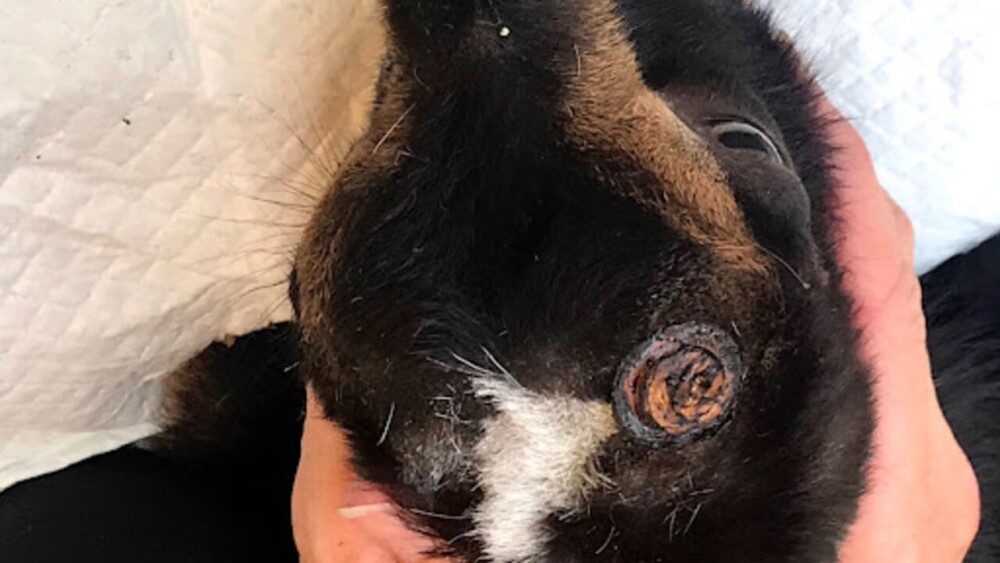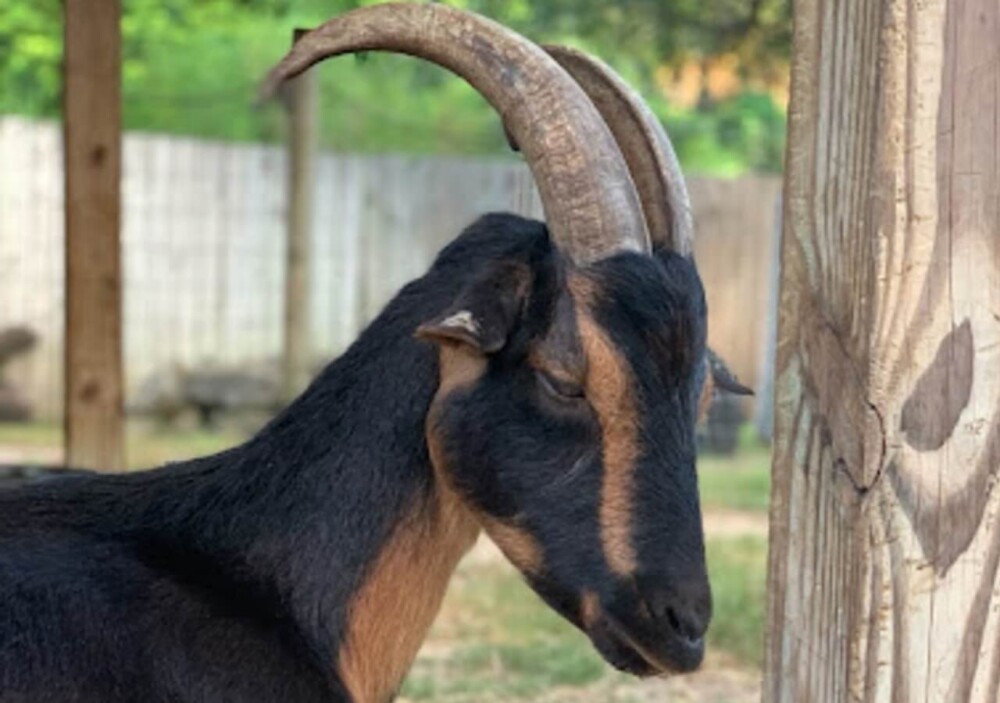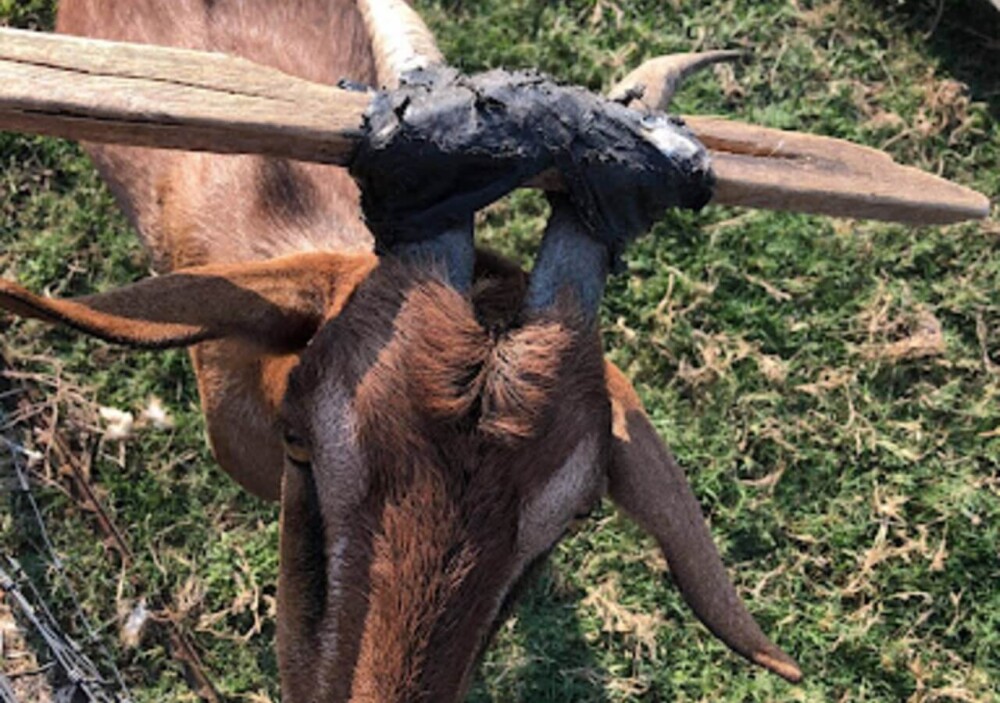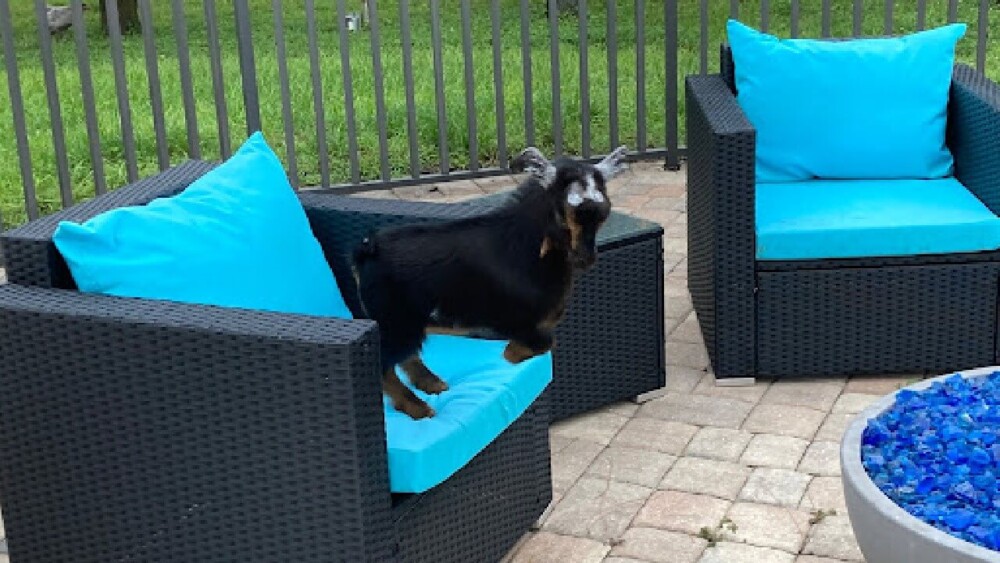Before ever deciding to breed your goats, you must make a difficult decision about the horns of their kids: should you disbud them? Most goat owners feel quite strongly one way or the other, so if you ask around, you’ll probably hear both sides of the argument.
The disbudding process requires an experienced person to burn off the ring of flesh and bud cells beneath the skin around the horns of very young goats. The small horn itself is also burned off and removed. If you correctly cauterize the bud cells, the horn does not grow back.

The dehorning process takes place when a vet surgically removes fully developed horns from a goat. It is much more complicated and more dangerous to the goat.
Should you disbud your goats? There are several reasons not to disbud your goats, including:
- you are in a hot climate and have little shade available
- you want to have something to grasp on the goat
- you have a high predator load and little protection
- you are squeamish about cauterizing the horn bud on a baby goat.
You may want to disbud your goats if:
- you intend to show dairy goats or participate in a 4H program with goats
- you want to sell them readily
- you have sufficient shade for your goats
- you have electrified fences
- you are worried about possible injury to yourself, loved ones, other goats, or the goat itself from goat horns.
Should you dehorn your goats? Dehorning requires a vet to sedate your goat and surgically remove developed horns. Dehorning opens the goat’s skull and exposes its sinuses. The sinus holes cannot be stitched shut, which makes infection a possibility. Only consider this stressful, complicated surgery as a last resort.
While the dehorning question is widely considered a last (expensive) resort, the disbudding question is a hot topic of debate.
When I was deciding regarding our goats, my first inclination was to research the evolutionary purpose of horns. Why do goats have horns, and how will not having them affect their health and well-being?
After researching the purpose of horns, I spoke to as many goat people as I could to hear their opinions. In addition, I polled a FaceBook “Goat Vets” page. This page allows people to ask goat vets for advice. Most of the respondents are goat owners, not necessarily goat vets, though vets may have added their opinions.
First, I wondered; “why did goats develop horns and what purpose do they still serve?” I’ll answer that question. I’ll also answer what the 1,129 goat people who responded to my poll said about dehorning.
And finally, I’ll share my own difficult decision about whether to disbud the kids born on my farm.
The Evolutionary Purpose of Goat Horns: Protection
Goats developed horns as a means to protect themselves against predators. In a 2018 National Geographic article entitled “Choose your weapon: How animals got their tusks, horns, and antlers,” Jason Bittel explains how tusks, horns, and antlers all seem to serve the same primary purpose: protection. So why did all three weapons evolve in related animals?
Whether animals evolved a tusk or a horn correlated to their environment: open spaces allowed for large, showy hood ornaments (moose, elk, and goats), while closed-in spaces required the compactness of a tusk for slashing (boars). The larger the horn, antler, or tusk, the more visible. This visibility may have reduced the need for physical combat.
So goats developed large horns because they lived in open spaces. The horns warned off potential predators even from a distance and provided them with protection if predators did approach.
Another article entitled “The Evolution of Horn-Like Organs,” by Valerius Geist (1966), specifies the many roles of animals’ horns. He explains that horns primarily allow:
- the males with the largest horns to get the girls
- the largest-horned males to dominate the other goats
- horned animals to shield themselves
- horned animals to do damage to predators or competitors
- some horned animals to grasp their competitors
- large-horned animals to scare off potential rivals or predators.

We’ll assess the pros and cons of these evolutionary purposes regarding your domesticated goat’s behavior and need for horns.
Horns: Getting the Girls
Pros: In wild herds of goats, the larger the horn, the more likely the buck is to mate with the does. If you have a large herd of meat goats and trust that the goats with the largest horns are also the most robust, you may want to allow this natural selection.
Cons: In many backyard herds, owners separate bucks and does so they can decide which goats to breed. Breeding may focus on genetics for meat or milk production or show quality stock. The size of the goats’ horns may be entirely irrelevant for such decisions.
Horns: Obvious Signs of Dominance
Pros: Goat herds are hierarchical. They establish their hierarchy by headbutting and other such displays to put and keep herd members in their place. The goats with the largest horns are usually at the top of the hierarchy. Once the herd establishes a goat as the head, the competition may stop or lessen.
Cons: While horn size helps to determine dominance, it does not necessarily stop competition. You can expect a good bit of head-butting and jostling for dominance, especially if no goat has larger horns than the others. This constant competition can lead to injury for the most competitive goats and those less able to protect themselves.
Horns: Head Weapons
Pros: Given that horns both shield the goats and allow them to attack, you may want your goats to grow horns if you know you have a heavy predator load in your environment and don’t trust your fencing or housing to provide adequate protection. If large enough, your goats’ horns will scare off predators before they even approach.
Cons: Just as goats use their horns to injure a predator, they can occasionally injure other goats in your herd. Injuries can happen both intentionally and accidentally. In addition to domination, goats use their horns to protect their feed and keep others from accessing it. Even if no goats are injured, horns may result in some hungry little goats.
Of course even without horns, resource competition is part of a goat herd. My polled goats push each other around every time they hear the feed bucket shaking. The little guys know to get out of the way of the big ones. It’s important to provide enough watering and feeding stations so that all of your goats have access to enough food and water.
Milking herds usually see the greatest risk of injury from horns. It is one thing to have a horn pierce a rib or side; it is quite another to have a full udder ripped open by a horn. When researching this article I came across several people who claimed to have started disbudding their herd after such an accident.

The Thermoregulatory (Cooling or Heating) Function of Horns
Many people believe that horns help to regulate a goat’s temperature. This theory is based on the fact that the core of goats’ horns are full of blood vessels. It is possible that the blood vessels in the core pump blood toward the outside of the horn, at which point it cools and heads back down to the goat’s body.
Cold goat breeds have developed horns with fewer blood vessels and a thicker outer coat. That means that less heat is lost by horned animals who live in the cold.
Pros: If these studies are accurate, there is value in maintaining horns on your goats if you live in an especially hot area and you do not have a great deal of shade available. The same would hold if you live in a cold climate and you have limited shelter.
Cons: If horns serve for thermoregulation, they are only one way goats regulate their temperature. This study discusses how a goat’s breathing and skin/coat interaction both regulate their temperature as well.
Goat Owners Speak Out: Facebook Responds to the Question: To Disbud or Not?
My FaceBook Goat Vets poll asked three questions.
One: Do you disbud all your goats?
Two: Do you disbud none of your goats?
Three: Do you disbud some of your goats?
I asked the people who only disbud some of their goats to explain in a comment why they chose some goats over others to disbud. I also invited everyone to explain their decision, but requested that people refrain from commenting on others’ posts, as I was concerned that tempers might flare.
As soon as I posted my poll questions, one of the moderators on the page tagged it as a “Hot Topic.” They do that when they want to watch a post carefully to be sure people remain civil.
I am happy to report that as of the time that I wrote this article, all 1,129 people who responded were civil. The breakdown of responses was as follows:
55.5% disbud none of their goats
36% disbud all of their goats
9.5% disbud some of their goats
I calculated the results several times over the two days the survey was active. Every time I ran the numbers, they were within a percentage point of this final calculation, so the informal survey was surprisingly reliable. The percentages remained stable from early on in the poll until the end.
Some of the reasons goat owners (55%) did not disbud or dehorn any of their goats were:
- I like having handles on my goats.
- I buy naturally polled goats
- If done improperly, it can be dangerous to a small goat.
- It is cruel.
- I don’t like dealing with scurs (the small horns that sometimes grow back after disbudding).
- It hurts when you’re headbutted even if goats don’t have horns.
- Goats need bumpers for herd dominance.
- Less stress on the animal.
- Their horns are natural radiators.
- It’s unsafe for the goat to lose their natural defense mechanism.
- Horns can be used to scratch itches.
- My goats have been good about not using their horns with me.
- I love the look of goats with horns.
The handsome look of goats with horns:

Here is a sampling of the reasons provided by the 36% of people who choose to disbud all their goats:
- I had my hand impaled and my wrist dislocated by a dairy doe who locked my wrist in her horns.
- I disbud for personal safety and the safety of my dairy goats.
- I am afraid they will get stuck in my electric fence and injure themselves.
- It’s easier to sell a goat that has no horns.
- I have dairy goats, so I disbud to protect their udders.
- I show my dairy goats, so it’s required.
- My goats are 4H, so it’s required.
- The vet gives my goat sedatives and lidocaine before she disbuds.
- My one goat not disbudded goat gets her head stuck in a fence 3-5 times a day.
- I used to have a mixed herd, but the horned goats bullied the polled and disbudded, so now I disbud them all.
- I have grandchildren around my goats.
- It is easier to use a milk stanchion without horns.
- I experienced several tragic injuries with horned goats, so now I disbud all our goats.
Here is a sampling of the reasoning of the 9.5% of people who disbud only some of their goats:
- I disbud dairy does for human safety.
- I disbud dairy bucks if the buyer wants them disbudded but leave them horned if they’re going to stay on my farm.
- My Boers keep their horns. They sweep back safely and are a breed standard.
- The only time I dehorn is when raising dairy goats because of udders getting horned or torn.
- My bucks are naturally polled, but all my does have horns.
- I have polled, horned, and disbudded goats. I sell disbudded because that’s what buyers want. I rarely have an issue with them getting stuck. My large animal vet does the disbudding.
- I disbud our dairy, show, and 4H goats. Animals intended for meat purposes and pasture goats keep horns for defense purposes. It’s a safety call.
- I disbud all does. Bucks that are market quality keep their horns. The breeders are disbudded.
My Personal Decision
I was surprised at how many people choose not to disbud their goats. Most of my goat friends disbud their babies, so I expected that to be the norm. I was wrong. We’re in the minority.
I only breed my does (who, unfortunately, are not polled) to my friends’ polled bucks. I hope to add as much polled genetics into my line as possible. Thus far my bucklings have been born polled but my doelings have had horn buds.
Before I decided whether to disbud, I made myself watch the disbudding process. I saw the disbudding iron and heard the screams of the kids as the vet tech applied the iron. It was as brutal as people say.
But I also saw the very same kid bound across its backyard just minutes after the procedure.
I admire the beauty of a goat with full horns and I loath the thought of the disbudding iron. Yet my toddler grandchildren spend hours every week on our farm. I made the difficult decision to disbud.
In addition to grandchild safety, I realized that the evolutionary purposes of horns are not relevant on my farm. My goats do not need horns for protection from predators as we have Livestock Guardian Dogs on our small hobby farm, so I am sure nothing will get past my dogs.
I have no intact bucks on my farm, so horns as a sign of mating stature are unnecessary. Our dominant goat (a wether) will remain so due to his size alone. He outweighs all the other goats by 40lbs. He doesn’t need horns to assert his dominance.
And my goats have ample deep shade and goat houses on stilts with open sides for wind circulation, so even in south Florida they can regulate their temperatures in various ways.
The practical uses of horns also didn’t interest me. I don’t need to use horns as handles, as I use the quick release collars to grab my goats when necessary.
Finally, the animals on my farm have injured me in the past. I know that animals can do serious damage, even when they do not intend to. I did not want to worry about losing an eye or being impaled by a moment of goat-play.
I asked my goat friends for recommendations and hired an experienced vet tech to disbud Jasmine, my goat. Melissa has years of experience disbudding and owns a large herd herself. We provided anesthesia before the procedure, and I used ice packs on Jasmine’s head just after Melissa cauterized the buds and sprayed them with aluminum spray.
The entire process took fewer than ten minutes, and though those ten minutes were physically painful for the goat and traumatic for me, I justify it by how quickly little Jasmine recovered. She first ran to her mama to nurse and then bounded off with her brother Aladdin to play on the porch. It was astonishing.
In the feature image, you can see the aluminum spray where Jasmine was just disbudded.
She hopped right back into action!
Despite my decision, I have a great deal of respect for people who allow their goats to grow horns. I understand their reasoning and admire their courage.
An Aside: Stuck Goats? Problem Solved!
One of the risks of goat horns that many people in my FaceBook poll mentioned was some goats’ tendency to get their horns stuck in a fence. While most goats quickly learn how to extract their horns from fence holes, some have difficulty figuring it out. And they are at risk of predators while they are stuck in the fence. Stuck goats can also face bullying, dehydration, and heat exhaustion.
I received a unique and fun way to stop goats from getting stuck in the fence from a responder on Facebook. She calls it the “stupid stick.” This is a stick she puts between her goats’ horns–from one horn to the other. Then she tapes the stick in place. She wraps gorilla tape in a figure-8 around the stick and the horns so the goat can’t knock the stick off.
With this stick between the horns, her goats cannot get their heads through fence holes. This may be a greater problem for goats in small pens or backyards than for larger herds of goats kept in a pasture with acres of land between them and the fences. But if it was a problem for you in the past, just try a stupid stick. It’s quite a clever contraption!
The stupid-stick solution to horns stuck in fences:

Final Thoughts
Like much in animal husbandry, the dehorning question is a personal decision that you should carefully consider before breeding your goats. There are evolutionary, practical, and emotional considerations that you should weigh as you decide. Talk to goat people, read as much as you can about it, and make an informed decision based on your particular farm.

Good luck!
My Essential Goat Supplies
This list contains affiliate products. Affiliate products do not cost more but helps to support BestFarmAnimals and our goal to provide farm animal owners with accurate and helpful information.
This little giant bucket fits on a fence and this one’s easy to carry.
A sturdy dog collar is essential. Don’t do rope (they’ll break and tangle) or chain (injury!).
A Black Water Tub is way nicer than buckets that tip over. I like to get a 20 or 30-gallon in each pen so my goats have plenty of water, but you can get 100-gallons if you have a lot of sheep in one pen.
Loose minerals in a small bag or a Purina 50 lb bag, and a mineral feeder for free-choice is the best option. One side holds minerals, and the other holds baking soda. Don’t feed sheep goat minerals because it usually contains copper- something that is fatal to sheep.
Hoof trimmers are a necessity because you’ll need to trim your sheep’s hooves every few months. These are nice for the price.
Don’t make the mistake I made by waiting to order a drench gun before you need it. I was surprised by how often I use it. It helps with bloating, dehydration, and other ailments. Here’s a good drench, but you can also drench a bloat solution or water if dehydrated.
Digital Thermometor for when your lambs act sick. You’ll need to know if their temps are too low or too high so you can accurately diagnose the issues.
Vetericyn for wound care. It makes a big difference in a speedy recovery.
Check out this list of goat milk supplies you need if you have milk goats.

